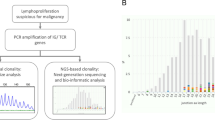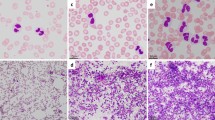Abstract
During follow-up of leukocyte counts in 20 consecutive patients (age range 29–81 years) treated with dasatinib, 9 patients (7 chronic myeloid leukemia in chronic phase, 2 Philadelphia chromosome-positive acute lymphoid leukemia in complete remission) developed lymphocytosis (>3,000/μl). Peripheral blood smears revealed a population of large granular lymphocytes. Large granular lymphocytosis (LGL) was first noted between 1 and 8 months after initiation of dasatinib, and it has persisted up to 33 months from the onset of LGL in one patient. Peak numbers of large granular lymphocytes ranged from 2,915 to 17,425/μl. The occurrence of LGL might interfere with achieving molecular response (MR, real-time quantification of major BCR-ABL1 mRNA less than 50 copies/μg RNA) in our small cohort; 8 (89%) of 9 patients with LGL attained MR, while only 6 (55%) of 11 patients without LGL eventually achieved MR. With respect to the relationship between LGL and pleural effusion (PE), 3 (27%) of 11 patients without LGL developed PE, while 5 (56%) of 9 patients with LGL developed PE. Moreover, the mean peak number of LGL was 9,215/μl, which was much higher than the mean peak number (4,635/μl) of LGL in patients without PE. These results may suggest possible association of both events in our cohorts.

Similar content being viewed by others
References
Talpaz M, Shah NP, Kantarjian H, Donato N, Nicoll J, Paquette R, et al. Dasatinib in imatinib-resistant Philadelphia chromosome-positive leukemias. N Engl J Med. 2006;354:2531–41.
Hochhaus A, Baccarani M, Kantarjian HM, Apperley JF, Lipton JH, Goldberg SL, et al. Dasatinib induces durable cytogenetic responses in patients with chronic myelogenous leukemia in chronic phase with resistance or intolerance to imatinib. Leukemia. 2008;22:1200–6.
Lombardo LJ, Lee FY, Chen P, Norris D, Barrish JC, Behnia K, et al. Discovery of N-(2-chloro-6-methyl-phenyl)-2-(6-(4-(2-hydroxyethyl)-piperazin-1-yl)-2-methylpyrimidin-4-ylamino)-thiazole-5-carboxamide (BMS-354825), a dual Src/Abl kinase inhibitor with potent antitumor activity in preclinical assays. J Med Chem. 2004;47:6658–61.
McKenzie SE, Reilly MP. The clot thickens (or not). Blood. 2009;114:1722–3.
Khoury HJ, Guilhot F, Hughes TP, Kim DW, Cortes JE. Dasatinib treatment for Philadelphia chromosome-positive leukemias: practical considerations. Cancer. 2009;115:1381–94.
Porkka K, Khoury HJ, Paquette RL, Matloub Y, Sinha R, Cortes JE. Dasatinib 100 mg once daily minimizes the occurrence of pleural effusion in patients with chronic myeloid leukemia in chronic phase and efficacy is unaffected in patients who develop pleural effusion. Cancer. 2010;116:377–86.
Bergeron A, Réa D, Rousselot P, Picard C, Meignin V, Tamburini J, et al. Lung abnormalities after dasatinib treatment for chronic myeloid leukemia: a case series. Am J Respir Crit Care Med. 2007;176:814–8.
Mustjoki S, Ekblom M, Arstila TP, Dybedal I, Epling-Burnette PK, Guilhot F, et al. Clonal expansion of T/NK-cells during tyrosine kinase inhibitor dasatinib therapy. Leukemia. 2009;23:1398–405.
Kim DH, Kamel-Reid S, Lipton JH, Sutherland R, Jung CW, Kim HJ, et al. Natural killer or natural killer/T cell lineage large granular lymphocytosis associated dasatinib therapy for Philadelphia chromosome positive leukemia. Haematologica. 2009;94:135–9.
Yamamoto M, Kakihana K, Ohashi K, Yamaguchi T, Tadokoro K, Akiyama H, et al. Serial monitoring of T315I BCR-ABL mutation by invader assay combined with RT-PCR. Int J Hematol. 2009;89:482–8.
Gruber F, Mustjoki S, Porkka K. Impact of tyrosine kinase inhibitors on patient outcomes in Philadelphia chromosome-positive acute lymphoblastic leukaemia. Br J Haematol. 2009;145:581–97.
Wong SF. Dasatinib dosing strategies in Philadelphia chromosome-positive leukemia. J Oncol Pharm Pract. 2009;15:17–27.
Kelly K, Swords R, Mahalingam D, Padmanabhan S, Giles FJ. Serosal inflammation (pleural and pericardial effusions) related to tyrosine kinase inhibitors. Target Oncol. 2009;4:99–105.
Quintás-Cardama A, Kantarjian H, O’brien S, Borthakur G, Bruzzi J, Munden R, et al. Pleural effusion in patients with chronic myelogenous leukemia treated with dasatinib after imatinib failure. J Clin Oncol. 2007;25:3908–14.
de Lavallade H, Punnialingam S, Milojkovic D, Bua M, Khorashad JS, Gabriel IH, et al. Pleural effusions in patients with chronic myeloid leukaemia treated with dasatinib may have an immune-mediated pathogenesis. Br J Haematol. 2008;141:745–7.
Giles FJ, O’Dwyer M, Swords R. Class effects of tyrosine kinase inhibitors in the treatment of chronic myeloid leukemia. Leukemia. 2009;23:1698–707.
Acknowledgments
This study was supported in part by a grant for clinical cancer research from the Ministry of Health, Labor and Welfare of Japan. The authors would like to thank the nursing staff at Tokyo Metropolitan Cancer and Infectious Diseases Center, Komagome Hospital, for their assistance in the collection of samples from patients included in this study. We are also grateful to the staff of the Hematology Division, Tokyo Metropolitan Cancer and Infectious Diseases Center at Komagome Hospital for their excellent patient care.
Author information
Authors and Affiliations
Corresponding author
About this article
Cite this article
Nagata, Y., Ohashi, K., Fukuda, S. et al. Clinical features of dasatinib-induced large granular lymphocytosis and pleural effusion. Int J Hematol 91, 799–807 (2010). https://doi.org/10.1007/s12185-010-0565-1
Received:
Revised:
Accepted:
Published:
Issue Date:
DOI: https://doi.org/10.1007/s12185-010-0565-1




